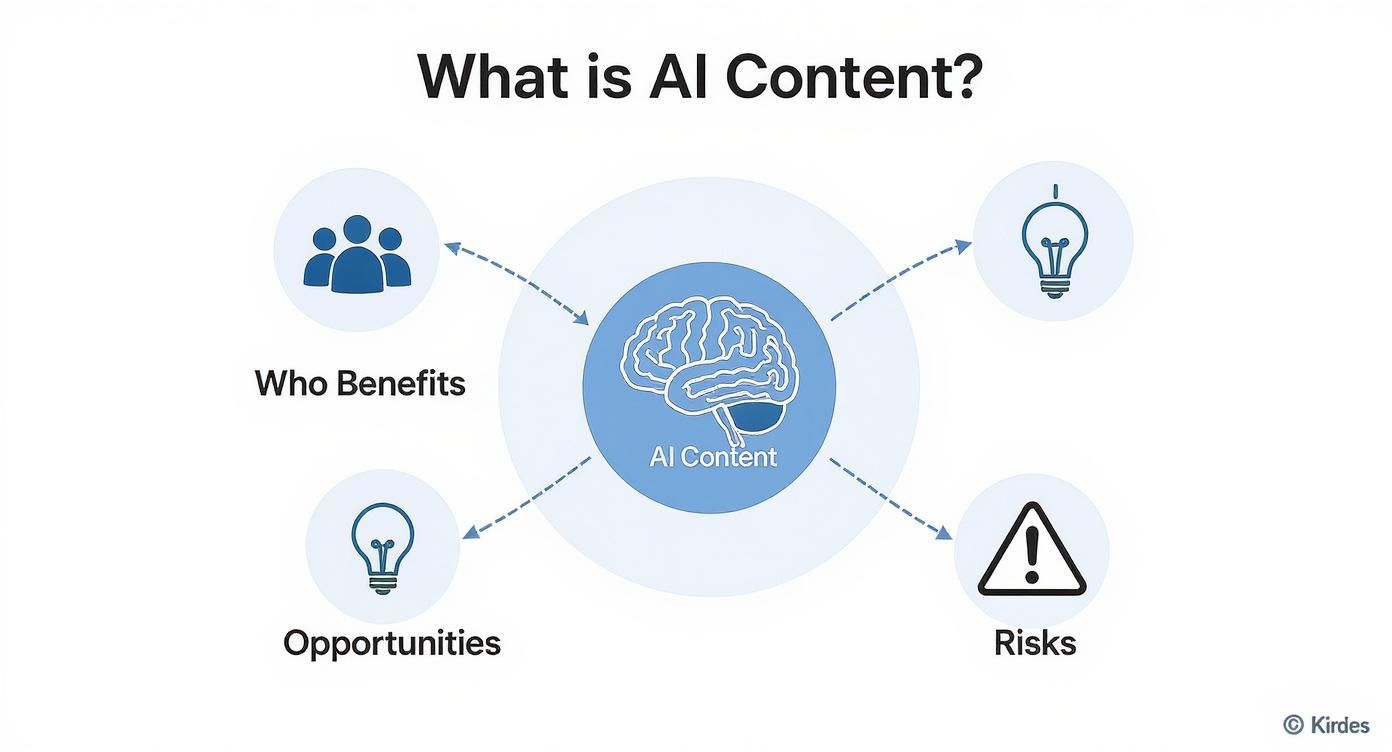
What Is AI Generated Content Explained
October 25, 2025
AI-generated content is pretty much what it sounds like: any text, image, audio, or video created by an artificial intelligence system. The AI gets there by first learning from staggering amounts of human-created data.
Think of it like a digital apprentice who has studied the entire internet. After analyzing countless examples, it can now produce original work that mimics the style it learned from. This isn't just about doing things faster; it's about creating on a scale we've never seen before.
What Is AI Generated Content, Really?
Imagine you wanted to teach someone to paint. You could show them every famous painting in history. After studying millions of examples, they'd start to see the patterns, styles, and techniques of different artists. Eventually, you could ask them to create a new painting "in the style of Van Gogh," and they could produce something original that echoes his work.
AI-generated content works on a similar principle, but with data instead of paint.
The process involves training complex algorithms—often called large language models (LLMs) or generative models—on massive datasets. The AI doesn’t "understand" the content the way a person does. Instead, it gets incredibly good at predicting the next logical piece of the puzzle. For text, it predicts the next word. For an image, it predicts the next pixel. This predictive power is what allows it to draft an email, design a logo, or even compose music.
AI Generated Content at a Glance
To really get a handle on it, it helps to break the whole thing down into its core parts. This technology isn't just one thing; it's a mix of processes that lead to a final creation. Here's a quick look.
| Aspect | Description |
|---|---|
| Input (The Prompt) | This is the instruction a human gives the AI. A good prompt is the key to getting good results. |
| The Model (The "Brain") | This is the trained algorithm that takes the prompt and generates content based on its learning. |
| Output (The Creation) | This is the final product—the blog post, social media update, or image the AI produces. |
As you can see, it's a straightforward process, but the results can be incredibly complex and powerful.
This technology has absolutely exploded in popularity, and its economic impact is hard to ignore. The global generative AI market was valued at a whopping $44.89 billion in 2025, a massive leap from just a few years earlier. With tools like ChatGPT pulling in billions of monthly visits, the market is on track to blow past $66.62 billion soon, which just goes to show how quickly it's becoming part of our daily work.
A key thing to remember about AI content is its ability to replicate human-like patterns with stunning accuracy. This is what can make it so tricky to tell the difference between human and machine-written text without some help.
If you really want to dig into how this works, it's worth understanding what characteristics AI detectors look for when they analyze a piece of content.
How AI Actually Learns to Create
It’s easy to think of AI content creation as some kind of digital magic, but it’s really just an incredibly advanced form of pattern recognition. At its core, an AI doesn’t "understand" a topic the way a person does. Instead, it learns to predict what should come next based on the mountains of data it was trained on.
Think of an AI as a student who has read a library containing nearly every book, article, and website ever published. The student's only job is to learn the relationships between words. It doesn't grasp the meaning of "love" or the concept of "justice," but it knows that certain words and phrases almost always show up together in specific contexts. This process is the foundation of what is AI generated content.
This infographic gives you a clear visual breakdown of the key elements, from who benefits to the opportunities and risks involved.

The map shows how the core technology branches out to impact different areas, highlighting its dual nature as both a powerful tool and a source of potential challenges.
The Brains Behind the Words: Large Language Models
The engine behind AI-generated text is a Large Language Model (LLM). Think of an LLM as the most sophisticated predictive text system you’ve ever seen. When your phone suggests the next word as you type, it's using a very simple model. An LLM does the same thing, just on a massive scale, predicting not just the next word but entire sentences and paragraphs with startling accuracy.
It pulls this off through a process called Natural Language Processing (NLP), which allows the machine to interpret and generate human language. The model is trained on trillions of words, helping it recognize grammar, style, tone, and context. If you want to go deeper, our guide on what is natural language processing explains this technology in more detail.
The real breakthrough with LLMs isn’t just predicting words; it’s understanding the subtle, contextual connections between them. This is what allows an LLM to generate text that is coherent, relevant, and often stylistically perfect for a given prompt.
For instance, when you ask an AI to write a blog post, it isn’t just pulling a pre-written article from a database. It’s building it word by word, using statistical probabilities to decide which word is most likely to follow the last one, all based on the patterns it learned during its training.
How AI Creates Images: Generative Adversarial Networks
Creating images takes a different but equally fascinating approach. Many AI image generators use a technology called a Generative Adversarial Network (GAN). A GAN works by pitting two neural networks against each other in a creative deathmatch.
Think of it as an artist and an art critic working together.
- The Generator (The Artist): This network’s job is to create images from scratch. At first, its creations are just random, messy digital noise.
- The Discriminator (The Critic): This network’s job is to look at images—both real ones from the training data and the fakes made by the Generator—and decide which is which.
The Generator constantly tries to create images that can fool the Discriminator. Every time the Discriminator spots a fake, the Generator learns and gets better. This back-and-forth happens millions of times, with both networks improving with each round.
Eventually, the Generator gets so good that the Discriminator can no longer reliably tell the difference between the AI-created images and real ones. It’s through this competitive process that AI learns to produce stunningly realistic and creative visuals.
Exploring Real-World AI Content Applications

The theory behind AI content is one thing, but seeing it work in the real world is where its power really clicks. These tools are no longer just cool experiments; they’re becoming essential parts of the daily grind in countless industries, solving real problems from marketing to software development.
Let's move past the hypotheticals and look at how people are actually using AI-generated content to get things done. This isn't science fiction anymore. It’s about driving a level of efficiency and scale that was almost unimaginable just a few years back.
Marketing and Sales Automation
Marketing teams were some of the first to jump on board, and for good reason. They’re constantly under pressure to create a high volume of personalized content, which makes the field a perfect match for AI.
Take email marketing, for example. Instead of blasting one generic message to everyone, a marketer can use AI to spin up dozens of versions for different audiences. An AI can instantly tweak a subject line to sound more buttoned-up for a B2B client or more laid-back for a direct-to-consumer brand, which can make a huge difference in open rates.
Here are a few other common ways marketers are putting AI to work:
- Blog Post Drafting: A content strategist can plug in a topic, a few keywords, and a rough outline. Minutes later, the AI spits out a full first draft, freeing up the human writer to focus on editing, adding their own insights, and making sure it fits the brand’s voice.
- Social Media Calendars: AI tools can whip up a month’s worth of social media captions based on recent blog posts or upcoming promos. Some can even suggest the right hashtags and the best times to post for maximum reach.
- Ad Copy Generation: For platforms like Google and Facebook, AI can generate hundreds of ad headlines and descriptions. This allows marketers to A/B test their messaging at lightning speed to find out what really resonates with customers.
E-commerce and Product Management
If you’ve ever run an online store, you know that managing thousands of product listings is a massive headache. Writing a unique, compelling, and SEO-friendly description for every single item is a nearly impossible task for a human team. That’s where AI comes in.
An e-commerce shop with 10,000 different electronics can use an AI to generate a unique description for every last one of them, practically overnight. Just feed the AI a spreadsheet with the specs—screen size, battery life, processor speed—and it can weave those details into readable, engaging paragraphs.
This isn't just a time-saver. It's about giving customers a better experience and boosting your visibility. Unique descriptions help products rank higher in search results and give shoppers the details they need to feel confident hitting that "buy" button.
The AI industry itself has become a huge economic force. By 2025, an estimated 90% of tech workers use AI tools in their daily jobs, but the impact is felt far beyond the software world. For instance, 66% of U.S. physicians now use AI in healthcare, showing just how widely this technology is being adopted. You can dig into more of these AI industry statistics on explodingtopics.com.
Creative and Technical Fields
AI's influence isn't just limited to text. In creative and technical roles, these tools are becoming the ultimate co-pilots, helping professionals brainstorm, prototype, and execute ideas faster than ever.
Game developers, for instance, use AI image generators to create concept art for characters, worlds, and in-game items. It lets them visualize different creative directions in a matter of hours, not weeks, without having to sink a ton of time into manual illustrations for every single idea.
It’s a similar story in software engineering:
- Code Generation: A developer can describe a function in plain English—"create a button that turns red when you click it"—and an AI can generate working code in Python, JavaScript, or C++.
- Code Documentation: AI can automatically write comments and documentation for existing code. This is a lifesaver for making complex software easier for the whole team to understand and maintain.
- Debugging Assistance: When a tricky error pops up, a developer can paste the broken code into an AI tool and ask for ideas on how to fix it. It's like having a senior engineer on call 24/7 to help you troubleshoot.
Comparing the Top AI Content Generation Tools
Jumping into the world of AI content tools can feel a bit like walking into a massive, noisy electronics store. Everything looks shiny, and every salesperson is promising their gadget will change your life. It’s easy to get overwhelmed.
But here’s the secret: the "best" tool doesn't exist. It all comes down to matching the right tool to the job you need to get done. The AI that’s a genius at writing a 3,000-word blog post might completely whiff when you ask it for a snappy, five-word social media caption.
Let's cut through the noise and look at the top players based on what you actually want to create.
Tools for AI Text Generation
Text generators are the most common AI tools out there, and they've come a long way. These are your digital writing assistants, ready to help with everything from a quick email draft to the first chapter of a novel.
ChatGPT (OpenAI): Think of ChatGPT as the Swiss Army knife of text generation. It's an all-rounder, great for brainstorming ideas, summarizing dense articles, and spitting out a solid first draft of almost anything. It's the perfect starting point for general-purpose writing tasks.
Jasper (Formerly Jarvis): This one is built for business. Jasper is a marketing and sales copy specialist, armed with templates for ad campaigns, product descriptions, and SEO-focused blog posts. If you need to churn out on-brand content at scale, this is your workhorse.
Copy.ai: While it's also a powerful marketing tool, Copy.ai really shines when it comes to creative, attention-grabbing copy. It’s fantastic for nailing down headlines, social media updates, and short-form content that needs a bit of personality. Its clean interface makes it incredibly friendly for beginners.
If you want to dig deeper into the options, checking out a roundup of the best AI writing software tools is a great way to see what else is out there.
Platforms for AI Image Creation
AI image generators are where things get really creative. You feed them a text prompt, and they dream up a visual. But each one has its own distinct artistic "eye," so your choice will dramatically shape the final image.
Choosing an AI image tool is like choosing a camera lens. Each one gives you a different perspective and aesthetic, so it's important to pick the one that aligns with your creative vision.
Midjourney: Favored by artists and designers, Midjourney is known for its beautiful, highly artistic, and often cinematic style. It excels at creating painterly images that feel like concept art or scenes from a fantasy film.
DALL-E 3 (OpenAI): Built right into ChatGPT Plus, DALL-E 3’s superpower is understanding language. It’s remarkably good at interpreting complex, detailed prompts and turning them into photorealistic images. This makes it a go-to for creating specific scenes or visuals for a marketing campaign.
Stable Diffusion: This one is for the tinkerers. As an open-source model, Stable Diffusion offers a level of control and flexibility you won't find anywhere else. It’s the top choice for developers and power users who want to fine-tune the AI, train it on their own datasets, and create truly customized visuals.
Comparison of Leading AI Content Generation Tools
To make the choice a little easier, here’s a quick-glance table comparing some of the most popular tools on the market. Think of this as a cheat sheet to help you narrow down your options based on what you need to create.
| Tool | Content Type | Best For | Key Feature |
|---|---|---|---|
| ChatGPT | Text | General-purpose writing and brainstorming | Conversational interface and versatility |
| Jasper | Text | Marketing copy and SEO content | Pre-built templates for specific business needs |
| Midjourney | Image | Artistic and stylized visuals | High-quality, cinematic image generation |
| DALL-E 3 | Image | Photorealistic and specific scenes | Excellent prompt comprehension and realism |
This table should give you a solid starting point, but the only real way to know what works for you is to get your hands dirty.
Ultimately, the best way to understand what is AI generated content is to experiment. Many of these platforms have free trials. Sign up, give yourself a small, low-stakes project, and just play around. You'll quickly get a feel for a tool's strengths and, more importantly, figure out which one clicks with your own workflow.
The Real Benefits and Risks of AI Content
Jumping into AI-generated content is like getting your hands on a powerful new tool. It can build incredible things faster than you ever imagined, but you also have to know how to handle it safely. The upside is huge, but ignoring the risks can create real problems down the road.
To get the full picture, you have to look at both sides of the coin. AI brings incredible speed and scale to the table, but it also forces us to deal with new challenges around accuracy, originality, and ethics. Understanding this balance is key for anyone trying to figure out how to use AI responsibly.
The Clear Advantages of Using AI
The first thing most people notice is the massive boost in speed and efficiency. Work that used to take hours—drafting articles, writing product descriptions, or whipping up social media posts—can now be knocked out in minutes. This lets individuals and teams pump out way more content without needing a giant budget.
And it’s not just about speed. The cost savings are a huge deal.
The numbers speak for themselves: AI-generated content is 4.7 times cheaper than content written by a human. On average, companies spend just $131 on an AI blog post versus $611 for a human-written one. This also means marketers using AI publish 42% more content. It's worth noting, though, that 97% of companies still have a human review the output before it goes live. You can find more of these AI content trends on ahrefs.com.
This kind of financial and operational freedom helps smaller teams compete with much bigger companies, leveling the playing field and creating new chances to grow.
Navigating the Potential Pitfalls
But this powerful tool isn't without its risks, and they require some careful management. One of the biggest issues is the problem of AI "hallucinations"—when a model states something that’s just plain wrong, but says it with complete confidence. Because AIs are built to sound convincing, these mistakes can be tricky to spot without some serious fact-checking.
Another major concern is the risk of creating generic, soulless content. An AI can mimic a writing style, but it doesn’t have real experiences, emotions, or a unique point of view. Relying on it too much can lead to a flood of bland, cookie-cutter articles that don’t connect with readers or build a memorable brand voice.
Finally, there are some thorny ethical and legal questions to think about:
- Copyright Concerns: Who actually owns the content an AI creates? The laws around this are still being figured out, and using AI-generated assets without clear rights is a gamble.
- Transparency Issues: Should you tell your audience that your content was made with AI? Hiding it can break trust if people find out later on.
- Detection and Penalties: While search engines say they care more about quality than origin, low-effort AI content can still get flagged. It’s smart to understand how AI detectors actually work and what they’re scanning for.
Ultimately, using AI for content is a trade-off. It gives you unmatched speed and scale, but it also demands more oversight, critical thinking, and ethical awareness from you—the human in the loop.
How to Elevate AI Content with a Human Touch
 The secret to getting great content from AI is to change how you think about it. The AI isn't your autopilot—it's your co-pilot. That raw output you get is just a starting point. It’s a well-structured, researched draft, but it’s completely soulless. The real magic happens when a person steps in to guide, refine, and give it a real voice.
The secret to getting great content from AI is to change how you think about it. The AI isn't your autopilot—it's your co-pilot. That raw output you get is just a starting point. It’s a well-structured, researched draft, but it’s completely soulless. The real magic happens when a person steps in to guide, refine, and give it a real voice.
This is how you turn generic text into a polished, trustworthy piece that actually connects with people. You’re taking the incredible speed and scale of a machine and blending it with what makes us human: experience, creativity, and gut instinct. The result is content that doesn't just rank well but builds a real relationship with your audience.
Start with Rigorous Fact-Checking
First things first: treat every single statement from an AI as unverified. AI models are famous for "hallucinations"—they'll state incorrect information with absolute confidence. Your job is to be the editor-in-chief and meticulously check every claim, number, and fact.
Always cross-reference stats with reputable, primary sources. If the AI cites a study, go find that study. If it gives you a number, track down the original report. This isn't optional. It’s how you build credibility and make sure you’re a reliable resource, not a source of bad information.
Inject Your Unique Brand Voice
An AI can mimic a tone, but it can’t fake your brand’s personality. This is where the human touch really sets you apart. Read through the draft and start swapping out the generic phrasing with your company’s unique style and terminology.
- Adjust the Vocabulary: Is your brand playful and witty, or more formal and authoritative? Replace bland words with language that fits.
- Refine Sentence Structure: AI loves long, robotic sentences. Break them up. Vary the rhythm to make the text flow naturally and keep readers engaged.
- Ensure Consistency: Make sure the tone here matches all your other marketing. You want to create a seamless experience for your audience, no matter where they find you.
If you’re trying to make AI text sound more natural, this guide on using an AI text humanizer offers a great overview for polishing your drafts.
Weave in Authentic Stories and Insights
A machine has never lived a day in your life. It can't share a personal story, a hard-won lesson, or a unique perspective you’ve gained from years of experience. This is your biggest advantage.
Your personal stories, case studies, and real-world examples are what turn a generic article into something memorable and valuable. An AI can explain what a concept is, but only you can explain what it means.
Look for spots to drop in a quick anecdote that proves your point. Share a client’s success story or a time you failed and learned something important. This is how you build an emotional connection with your audience—something an algorithm will never be able to do. By layering your expertise over the AI's foundation, you create content that’s both efficient and exceptional.
Common Questions About AI-Generated Content
As you start experimenting with AI content tools, a few big questions almost always pop up. Getting clear answers is the key to using this tech smartly and ethically.
So, let's cut through the noise and tackle the most common points of confusion. Think of this as your quick-start FAQ for working with AI.
Can Google Detect AI-Generated Content?
Yes, Google can. Its algorithms are smart enough to spot the patterns common in AI writing. But here’s the thing: Google doesn't really care how the content was made. It cares if it's any good.
Google’s official stance is to reward helpful, high-quality content that actually serves the reader. The real risk isn’t getting "caught" using AI; it’s using AI to churn out spammy, low-value articles that help no one. Your goal should be to use AI as a collaborator to create great stuff, not as a shortcut to skip the work.
Who Owns the Copyright to AI Content?
This is where things get a little murky. Copyright law for work created by an AI is still a developing gray area. In the United States, copyright has traditionally protected works of human authorship. This means content spit out by an AI with zero human input probably isn't eligible for copyright.
But if you take that AI output and substantially edit, rearrange, or add your own creative spin to it, your contributions could be protected. You're adding the human element.
Because the legal landscape is shifting, it’s always a good idea to talk to a legal professional for specific use cases, especially if you're working on commercial projects. Better safe than sorry.
Is Using AI Content Plagiarism?
Nope, not inherently. Plagiarism is when you pass off someone else's work as your own. Since AI models generate new combinations of text from their training data, the output is technically original. It's not copying and pasting from a single source.
The catch? AI models learn from a massive trove of human-created content. Sometimes, they can accidentally generate text that’s a little too close to the source material. To stay in the clear, always run your AI drafts through a plagiarism checker, fact-check everything, and—most importantly—edit heavily to inject your own voice and perspective.
Will AI Replace Content Creator Jobs?
It's far more likely to change them than to eliminate them. AI is fantastic at automating the grunt work—the repetitive, time-sucking tasks that slow creators down. This frees up humans to focus on what we do best: high-level strategy, original ideas, and deep, nuanced storytelling.
The role of a writer is already shifting. Think of it less as a "writer" and more as an "AI director." You're the one guiding the tool, refining its output, and adding the critical thinking and emotional intelligence that machines just don't have. The demand for skilled pros who can master this human-AI partnership is only going to grow.
Ready to turn your AI drafts into polished, human-sounding text? Natural Write makes it easy to refine your content, bypass AI detection, and let your unique voice shine through. Try our free humanizer today and see the difference.


